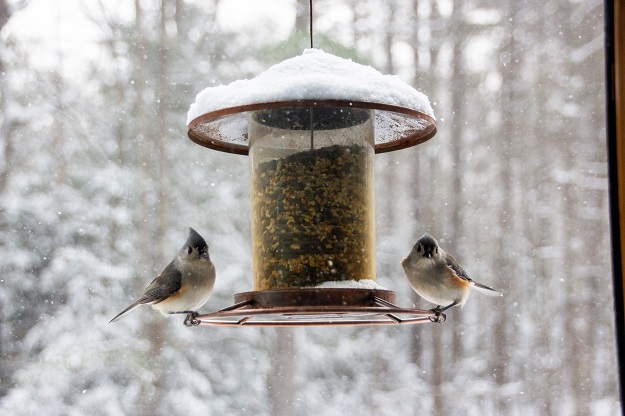Birds visiting feeders, munching on the coneflower seeds in the garden and perching in the shelter of evergreens help brighten the long, often dreary days of winter. Just like gardening, bird watching helps us connect with nature, reduces stress, and elevates our mood. Plus, birds also help manage insect pests. Protein-rich insects and spiders are an essential part of the diet of 96 percent of North American terrestrial birds.

Growing a landscape filled with plants that provide seeds, berries and shelter is a great way to attract these welcome guests to our gardens. Providing additional sources of food, water and shelter can increase the number and diversity of the winged visitors.
Create a bird feeding station so you can easily watch the birds and enjoy their songs. Include a variety of feeders suited to the birds you want to attract. Select feeders that are easy to fill and clean and protect seed from weather and squirrels.
You’ll attract a wide range of birds with tray and platform feeders. Look for ones that have a cover to protect the seed from rain and snow and a removable mesh floor for easy cleaning. Platform feeders, with excellent drainage, help minimize the risk of wet seed sprouting or supporting bacteria and fungi that can harm the birds. Help keep seeds safe and fresh with regular cleaning and by only providing enough seed for a day or two.
Hopper or house feeders protect seed against the weather and bird droppings. But if the seed gets wet, the closed environment is perfect for bacteria and fungi to thrive. Plus, they are more difficult to clean.
Tube feeders are cylinders with perches and feeding ports. Those with perches above the openings attract birds like goldfinches and chickadees that can feed upside down. Those with small perches discourage large birds from feeding. Select tube feeders with small ports for smaller seeds like Nyjer thistle and ones with larger openings for large seeds.
Look for ones with wire surrounds to keep out squirrels and those with a removable bottom that are easy to clean. Reduce problems on other tube feeders by blocking the bottom of the tube that extends below the lowest feeding port. Seed and water can collect there, increasing the risk of fungi and bacteria.
Clean feeders regularly with a 10% non-chlorine bleach solution, commercial birdfeeder cleaner or mild solution of unscented dishwashing soap. Wash the inside and outside of the feeder, perches and feeding ports. Once cleaned, rinse with clear water and dry before refilling.
Provide some shelter from wind, snow, rain, and predators for birds spending the winter in your landscape. Supplement what trees and shrubs provide by including a few roosting boxes and pockets.
Make sure to provide water throughout the year. Those in colder climates will need to add a heater, bubbler, or aerator to prevent the water from freezing. Providing fresh water reduces the calories and body heat a bird uses when melting snow and ice.
Select a birdbath that can be left outside year-round to avoid cracks and leaks as water freezes. Place it in a sunny area and add a few stones so the birds can take a sip without getting totally wet. Keep these clean just as you do during warmer months.
Melinda Myers has written more than 20 gardening books, including Small Space Gardening. She hosts the “How to Grow Anything” DVD series and the Melinda’s Garden Moment TV & radio segments. Her website is MelindaMyers.com.
Related Articles & Free Email Newsletter
Bring in the Birds with These Plants
Creating a Backyard Bird Sanctuary




Comment here